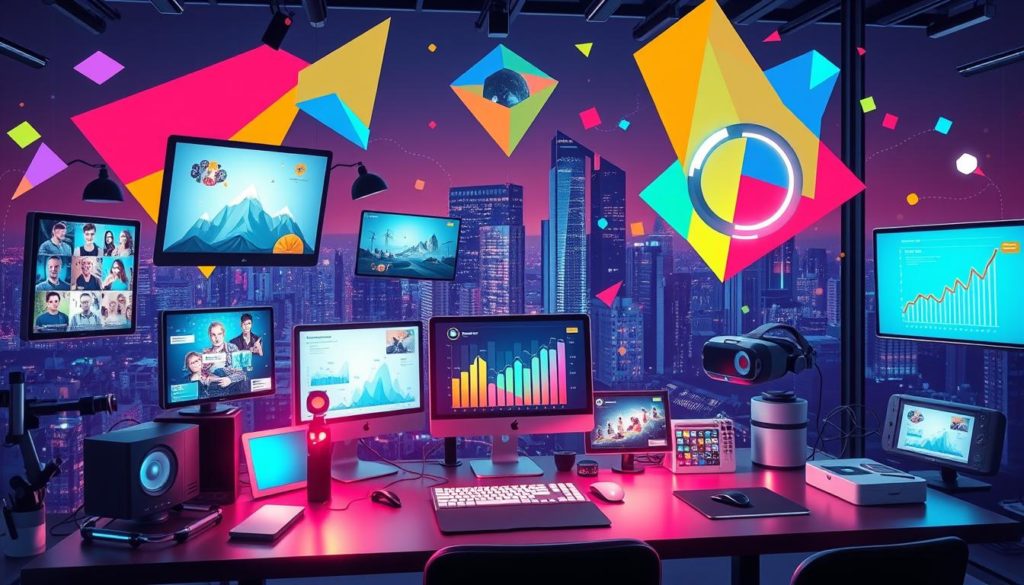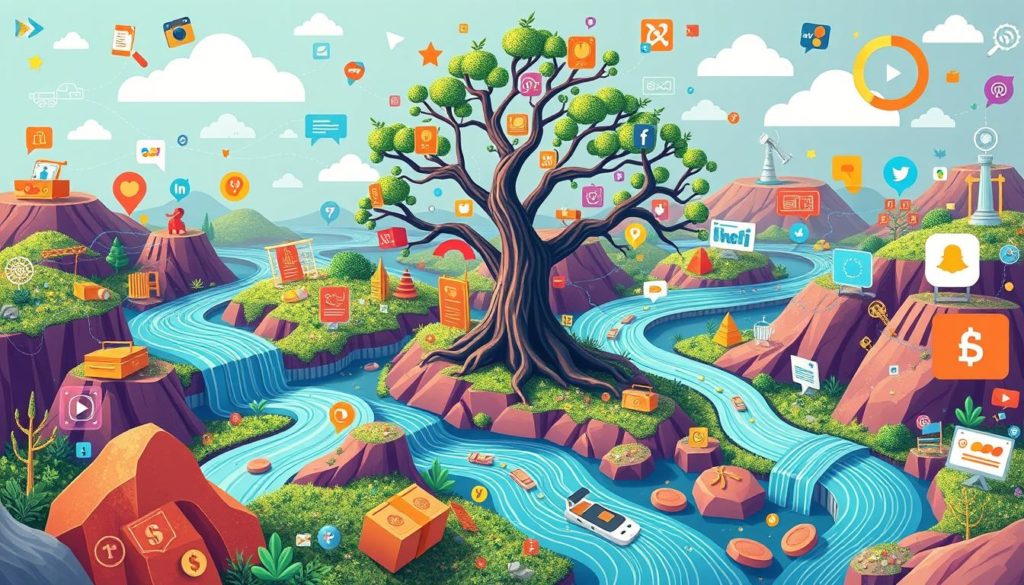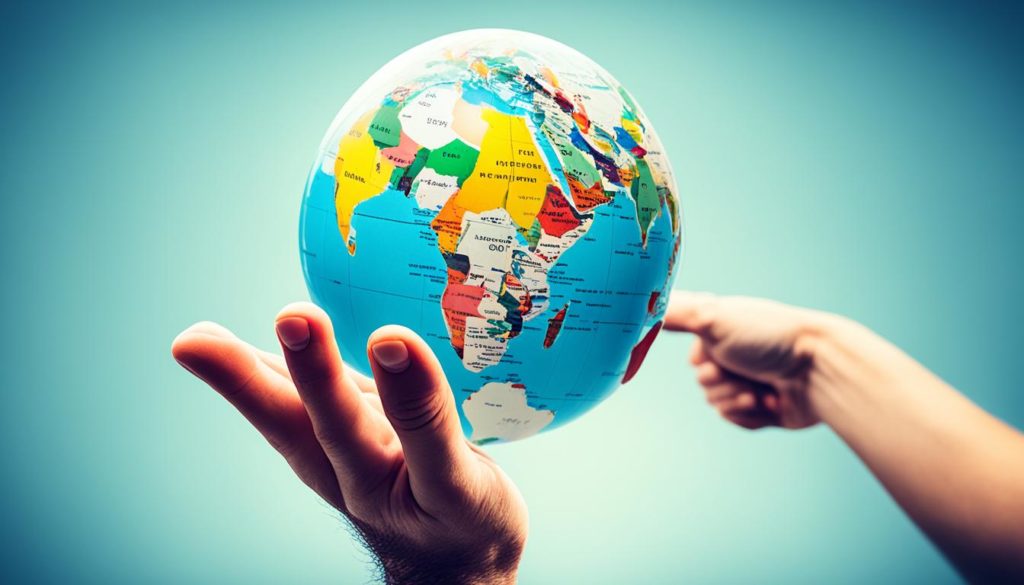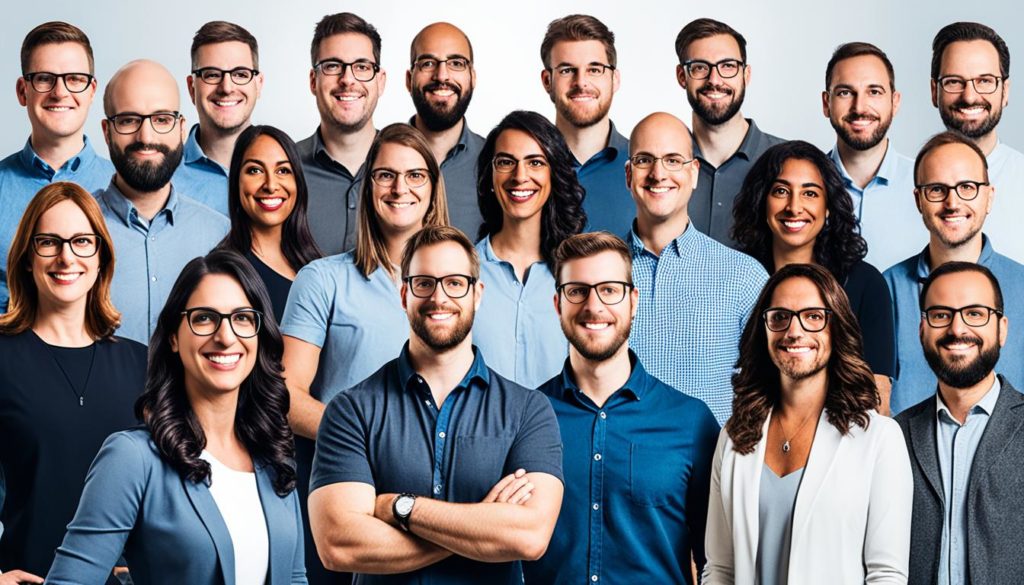
Did you know the creator-influencer market is expected to hit $13.8 billion this year? This growing field is attracting brands from all over to the digital communities created by entrepreneurs.
Amway is a major player in this area. With over $8 billion in sales and operations in more than 100 countries, Amway is using People, Platforms, and Passion to support entrepreneurship. Milind Pant, Amway’s CEO, says that a love for people and easy access to platforms are key for today’s entrepreneurs. This approach is working, with 75% of Amway’s sales coming from a wide area, from Mumbai to Tokyo.
Amway’s “A Million Entrepreneurs” program shows their dedication to helping micro-entrepreneurs in health and wellness. These entrepreneurs use digital tools to grow their businesses, showing the heart of the creator economy. For example, Pramilla Ohlson in India has over 80,000 followers on Instagram thanks to Amway, proving the impact of these efforts.
Exploring the creator economy, we see old barriers falling down thanks to new tech. Brands are teaming up with TikTok and Instagram to reach their audiences directly. Also, the rise of subscription services shows a move towards unique content and steady income for creators.
Key Takeaways
- The creator-influencer market is projected to be worth $13.8 billion this year.
- Amway, with $8 billion in revenue, is leveraging the People, Platforms, and Passion model to foster entrepreneurs in over 100 countries.
- Brands are increasingly partnering with digital platforms like TikTok and Instagram for promotional activities.
- Subscription-based models are on the rise, showcasing a shift towards exclusive content for recurring fees.
- Micro-entrepreneurs are reshaping the traditional direct-selling model through digital and social commerce.
The Foundations of the Creator Economy
The Creator Economy has changed how people connect and make money from their creativity. It’s built on two key things: making technology more accessible and removing old barriers.
Democratization of Technology
Platforms like YouTube, Instagram, TikTok, and Patreon have changed the game. They let creators share and make money without old industry rules. This change was clear during the COVID-19 pandemic, when many started creating content for income.
These digital spaces offer many ways to make money, from ads to selling merchandise. They connect creators with their fans, creating a lively online world. For example, YouTube started the YouTube Shorts Fund to help creators compete with TikTok. Twitch also lets streamers make money through subscriptions and Bits.
Dissolution of Traditional Gatekeepers
The Creator Economy has shaken up old industries by cutting out middlemen. Creators can now reach their fans directly, building their own brands online. This has led to a big rise in influencer marketing, with brands teaming up with social media stars for campaigns.
Collaborations like Shein and TikTok’s Drew Afualo show how influencers can boost sales. Creators connect with fans through live streams and Q&A sessions, building a loyal community. This shift is more than a trend; it’s a fundamental change in how content is shared and creators make a living.
Key players in this world include creators, influencers, platforms, brands, agencies, investors, and regulators. This network drives the growth of the creator economy, changing the media, entertainment, and marketing fields. With over 50 million creators globally, there are many chances for new talent to succeed.
Monetization Strategies for Content Creators
In the ever-changing creator economy, content creators have many ways to make money. They can go from traditional ads to creating digital products.
Ad Revenue and Sponsorships
Many creators make money through ads and sponsorships. YouTube lets creators earn from ads in their videos. They can also work with brands for sponsored content.
This way, creators can team up with companies that fit their brand. For example, Chiara Ferragni has worked with big names like Dior. This shows how powerful these partnerships can be.
Crowdfunding and Patronage
Platforms like Patreon, Kickstarter, and Indiegogo help creators get money from fans. This builds a loyal community that supports exclusive content.
For example, the Exploding Kittens Kickstarter campaign raised over $8 million. This shows how crowdfunding can be a great way to make money.
Merchandise and E-commerce
Creators can also make money by selling merchandise and products online. Selling items on Etsy, Redbubble, and Society6 can bring in revenue. It also helps creators connect with their fans.
For example, PewDiePie has built a big merchandise line. This has helped him earn a lot of money.
Digital Products and Online Courses
Creating digital products or online courses is another way to make money. Platforms like Udemy, Skillshare, and Teachable let creators sell courses.
For example, photographer Peter McKinnon sells courses on filmmaking. These courses give valuable tips to both aspiring creators and fans.
NFTs and Digital Art
NFTs and digital art sales on blockchain platforms are a new chance for creators. They can sell unique digital items directly to their audience. This opens up new ways for digital artists to make money.
This shift changes how creative works are valued and sold. It’s a big change for the digital art world.
Building and Engaging Online Communities
The creator economy thrives on building online communities. Here, being real and relatable is key. With Gen Z moving to private platforms, we can create deeper connections.
Authenticity and Relatability
Connecting with your audience in a real way is essential. Creators like Pramilla Ohlson have grown large communities by being themselves. Her Instagram has over 80K followers.
Being authentic and relatable builds loyalty. It’s not just about having many followers. It’s about the quality of your connection with them.
Leveraging Social Media Platforms
Social media is vital for creators. It lets them connect directly with their audience. They can grow their personal brand and share content that fits their followers’ needs.
Platforms like Skool Games offer live workshops and challenges. They help creators engage with their community in new ways. Using these platforms creatively boosts interaction and reach.
Retaining and Growing Your Audience
Keeping and growing your audience is all about value. Share content that speaks to your community’s interests. Social media and community involvement are key to keeping your audience active.
Skool Games uses gamification to keep people engaged. It offers live workshops and real-time help. This supports creators in building their communities.
Success stories from Skool Games show the power of community. By finding your passion and creating engaging content, you can earn money. The creator economy is worth $100 billion, with Gen Z eager to join.
The Role of Micro-Creators in the Creator Economy
In the creator economy, micro-creators are making a big impact. They focus on specific niches, building strong bonds with their fans. This approach leads to more meaningful interactions than big influencers can offer.
Micro-Creators versus Major Influencers
Micro-creators stand out from big influencers. They have smaller but more dedicated followings. A report by The Hustle shows a 50% jump in YouTube channels earning six figures a year, highlighting their growing influence.
Building Authentic Communities
Micro-creators excel in building real communities. They connect with their fans on a personal level, especially on TikTok. A FreshBooks survey found 53% of self-employed people earn more than they did in traditional jobs, showing the financial benefits of online communities.
Monetization Potential for Micro-Creators
Micro-creators have a lot of earning potential. An Upwork survey found 61% of freelancers feel more secure in their jobs than in traditional employment. Brands are now focusing on micro-influencers for their real connections and high engagement rates.
The influencer marketing industry is growing fast, reaching $21.1 billion. This shows marketers are valuing partnerships with micro-creators more than ever.
| Aspect | Micro-Creators | Major Influencers |
|---|---|---|
| Audience | Niche and Engaged | Broad and Varied |
| Engagement Rate | Higher | Lower |
| Authenticity | High | Varies |
| Monetization | Strong Potential | Established but Saturated |
Micro-creators are leading the creator economy. They build real communities and have big earning potential. It’s no surprise brands are turning to them for genuine connections.
Challenges and Opportunities in the Creator Economy
The creator economy has grown fast, with about 50 million people worldwide calling themselves creators. But this growth brings its own set of challenges and chances.
Overcoming Market Saturation
As more people join the creator economy, the market gets crowded. The industry is expected to hit nearly half a trillion by 2027. Creators need to find new ways to be noticed, using creativity and teamwork.
Algorithm Dependence
Platforms like YouTube and Instagram change their algorithms often. This affects how visible and engaging content is. Creators must be quick to adjust their strategies to stay seen.
Ensuring Sustainable Income Streams
Only about 12% of creators make more than $50,000 a year, while most earn under $1,000. To be stable, creators should look into different ways to make money, like ads, sponsorships, and selling digital products.
Content Moderation and Platform Policies
How platforms moderate content and their rules are key. Creators must understand these to keep their work visible and follow the rules. Finding a balance between creativity and following rules is crucial for lasting success.
- Challenges:
- Market Saturation
- Algorithm Dependence
- Income Variability
- Content Moderation
- Opportunities:
- Innovative Content Strategies
- Platform Adaptation
- Diverse Revenue Streams
- Policy Navigation Skills
| Key Metrics | Value |
|---|---|
| Projected Value of Creator Economy (2027) | $500 billion |
| Percentage of Creators Earning Over $50,000 | 12% |
| Growth Rate of Creator Economy in India | 25% CAGR |
| Investment in Creator Startups (Last few years) | $5 billion |
| Full-time Equivalent Jobs Supported by YouTube in India (2021) | 750,000 |
Conclusion
The creator economy is a new mix of creativity and business in our digital world. It’s growing fast, expected to hit over $250 billion by 2024. With TikTok, Instagram, and Snapchat having almost a billion users, creators have many ways to make money.
But, creators face big challenges. Over 40% struggle with endless work, scams, and high expectations. It’s key to find ways to work sustainably and wisely. From big influencers making $344,000 a year to small ones making money through relatability, the future of work is diverse.
Places like Rushford Business School help by teaching entrepreneurship. They give students the skills to succeed in the digital world. Networking and partnerships help turn dreams into reality, bringing new ideas to the table.
Exploring the creator economy further, check out more here. This path towards a more open, adaptable, and rewarding economy is thrilling. Together, we can unlock its full potential.
FAQ
What is the Creator Economy?
The Creator Economy is a place where people use digital platforms like YouTube and Instagram to make content. They connect with their audience and make money from it. It’s all about using technology to let anyone create and earn money, without needing big companies.
How do content creators monetize their efforts?
Creators can make money in many ways. They get ad money from YouTube, work with brands, and use Patreon for crowdfunding. They also sell merchandise, digital products, and even NFTs on blockchain platforms.
What makes the Creator Economy different from traditional media industries?
The Creator Economy changes the game by letting anyone join in. You don’t need a big publisher or studio to start. It’s all about connecting directly with your audience and making money your own way.
How does a content creator build and engage an online community?
Building a community means being real and connecting with your audience. Share content that people can relate to, talk to your followers, and use social media to chat directly. Make content that matters to your audience’s interests and values.
What are the key challenges in the Creator Economy?
Challenges include too many creators, relying on algorithms, and making money that’s not always steady. Creators must find different ways to earn and keep up with platform changes to keep going.
What is the role of micro-creators in the Creator Economy?
Micro-creators are important because they create real connections with their audience. They often have more engaged followers and are seen as more trustworthy than big influencers.
How can micro-creators monetize their audience effectively?
Micro-creators can make money through collaborations, offering unique experiences, selling niche items, and digital products. They can also use crowdfunding. Their close community ties make these methods very effective.
What is Amway’s approach to supporting digital entrepreneurship?
Amway helps digital entrepreneurs through its “A Million Entrepreneurs” program. It supports people in over 100 countries in health and wellness. They focus on passion, positive attitude, and making it accessible for everyone to start a business.
How can content creators ensure sustainable income streams?
To make sure they keep earning, creators should mix different ways to make money. This includes ads, sponsorships, selling products, and crowdfunding. This way, they can avoid relying on just one thing and stay financially stable.
What future opportunities does the Creator Economy present?
The Creator Economy’s future is bright with chances for new ideas, working with other industries, and making a global impact. As tech gets better, new ways to make money will come up, helping creators keep their careers going strong.
Future App Studios is an award-winning software development & outsourcing company. Our team of experts is ready to craft the solution your company needs.










